Deciphering the Results of the Flame Test
| tl;dr : If you don’t care to understand “why” then focus on the Header text, the color-coded bullet lists below, and the color-coded photo examples. This will explain everything you need to know to educate your readers, customers and yourselves. It’s important to get the info right! |
Yes, Silicone Can Burn
A couple years ago I created a big post with videos talking all about how you can flame test sex toys to see if they’re really silicone or not. But the silicone styles being used in the industry are changing and are more varied than we thought, and so the flame test isn’t as easy to decipher as we thought. It used to be thought that it was pretty black and white – silicone won’t “burn”. “If it burns, it’s not silicone”. “Silicone won’t melt” is another one. But what do YOU think of when you think of something burning? What results would you expect? You may expect nothing to happen, for the silicone to be utterly resistant to the heat of the flame. And that is partially true – your results vary depending on where on the item you flame test. If you flame test the middle of the flat base, or the shaft of the insertable portion, there is no edge or no seam. When the silicone is thinner and softer, that’s when it can burn. But there’s a large difference between the smoldering like the ashes of a nearly-dead campfire and the flames of a torch. In my interview with Metis, she told me that we could expect pale gray ash. The ash was the marker of the silicone, but that it would brush off with no damage. We thought this of the Jimmyjane Hello Touch. It burned, it produced the tell-tale dry ash of silicone oils, but it also showed material loss and stickiness. This confused us. It got sent off to a lab test, and it was proven to in fact be 100% silicone.
Yes, Silicone Can Get Sticky from the Heat of a Flame
After the third person mentioned the “sticky”, I asked Metis her thoughts. She weighed in on this with some thoughts that it could be down to a difference in the amount of softening silicone oils present or a difference in the types of silicone. RTV, LIM. One is poured, one is injected. This difference in silicone types could be why some appear to burn/smolder more than others or why some get sticky and you’ll see some material loss. One theory I have is that many of the dildos that frequently got flame tested were made with RTV type silicone; it would have been much less likely to be thin/soft/stretchy silicone so therefore less likely to produce excess flame, sticky material, etc. A few years ago, RTV type would have been much more prevalent, therefore the RTV type silicone was used as the “this is how silicone should behave” standard. One constant I see, though, is the presence of the pale-grey / white ash if it is silicone and if any “burn” happens. It might burn because the sample is so thin (like the Hello Touch) or because you caught a sharp edge/seam — but there was still ash left behind. Also when true silicone burns like this, it usually will quickly extinguish on its own….unless you have a situation like the Bedroom Kandi kegel beads.
I admit: We were wrong about the Bedroom Kandi kegel bead holster. I remember a few years ago at the conference, I was showing my results to a number of industry professionals and asking their opinion before I said it publicly on my blog. Everyone said “that’s not how silicone behaves, I don’t think it’s silicone”. But! It produced ash! If we posit that ash is a defining marker of silicone, then yeah….the BK Hold On To Me bead holster is silicone. Why did it burn up like it did, so fast? Because it was a very thin piece of silicone, LIM type, made to be extra soft and stretchy. There were a lot of silicone oils to burn and it didn’t leave a lot of solid materials behind.
Embrace Your Inner Pyro and Observe
Get out your lighter, an empty bowl, some water, and a camera if you want. Apply the tip of the orange flame to the sex toy and see HOW it burns. One thing that a pure silicone will NOT do, no matter what type it is, is burn like an oil lamp. I’ve had these weird TPR things go up in flames, burning bright, high and hot. I’ve seen the more firm versions of TPR-type materials (this is rare in the sex toy world) not do anything at first….they just absorb the heat of the flame, and then get all smooshy and melty and pliable. I tested a cock ring that is called “SEBS Silicone” by Screaming O. A lot of retailers who don’t know any better look at that and say “oh, silicone!” and list it on their site as such. Pure silicone will never be crystal clear and see-through1. The extreme stretch and the jelly look of the material means it’s not silicone.
Results from a flame test that likely indicate silicone (a few of these at once are normal, or just one):
- Pale-to-medium gray ash which is easily removed
- A small amount of material damage and “flaking”, leaving behind a sticky patch
- No change
- Black, sooty mark that rubs off easily
- Black, sooty mark that doesn’t rub off 100%
Results that likely indicate it is not silicone include a lack of gray ash as noted above plus:
- Easily catches fire to a hot, large flame that must be doused with water
- Completely melted and deformed material
- Material that looks charred black and melted (think of what melted plastic containers look like)
- Catches fire and spreads quickly over the material as if an accelerant were involved
- Does not catch fire, just absorbs the heat and eventually deforms. Material is pliable and soft when still warm.
Below, I have some photos I’ve taken of the flame test process on some known materials. Then I have some readers who wrote in with their questions on their flame test results.
—————————————————————-
SILICONE: First up is a silicone cock ring from CalExotics. It’s “clear”, but it’s cloudy-clear. The stretch amount isn’t anything like a “jelly” ring. You’ll see in the first photo that I was able to get some ash. It did smolder because I caught a seam, but I couldn’t get the photo of that in time. Next, you can see a section where there is a bit of obvious material loss. Still, though, I can stretch the ring and it doesn’t tear. Finally, I’ve stretched it out a little and you can see slight scorch marks that I was able to mostly wipe off, plus little areas that are slightly different looking.
![]()
![]()
![]()
SILICONE: This is the Bedroom Kandi kegel bead set with a silicone holster. This was the first item to trick us. First you can see it smoldering and producing white ash. It burned a lot more/faster in my original flame test video, because I was burning the thin retrieval cord. Next up you can see that the material looks different after I blew the ash off. Finally, you can see that a part of the material is sticking to my finger. The section where it burned was sticky to the touch. It isn’t nearly as sticky the day after burning.



SILICONE: This is some Tantus silicone. First up in pink is a representative of their firmer silicone. This is the base of one of the handled dildos. I couldn’t get it to burn, therefore no ash, but it scorched from the lighter. Perhaps if I were using a cleaner type of lighter, I would have less of the black soot. Next up though you can see that the black soot was easily wiped clean. However on their much softer O2 material, I had trouble getting the soot mark to completely rub off.



NOT SILICONE: This is a Screaming O cock ring with the plastic bullet removed. Their packaging calls it jelly material in one section, but “SEBS Silicone” in another and then goes on to say that this is a disposable ring and shouldn’t be used again. That doesn’t sound like silicone to me! Plus this material is super soft, very clear, and extremely stretchy. In the first photo, you can see it burning like an oil lamp. This happened quickly and without much provocation. Unlike the silicone flames, I couldn’t blow this out, and had to dump water on it. You can see in the next photo where the most recently burned portion is puddling out into the water. In the last photo you can see a more severe case of it melting, and even see that the material is browned a bit from scorching. This was from a previous burn that held on longer because I forgot to bring water over and had to rush it to the kitchen sink.
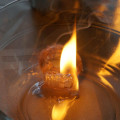

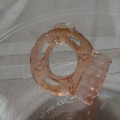
NOT SILICONE: This is an old-school CalExotics rabbit vibe. The packaging doesn’t even say phthalates-free. The material feels WEIRD. It is more firm than I expected, and the surface is as smooth as glossy hard plastic. It stinks like a sweet shower curtain smell. When it burns, the fumes are extremely pungent, much moreso than the Screaming O ring. So in the first photo you can see the tip of the bunny ear flaming away. Then you can see the black scorch of melted and burnt material. That’s exactly what it’s like….burnt plastic. The burnt part is hard now. The flames didn’t want to die down easy and I had to dump water on it before it got out of control.
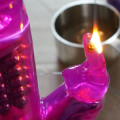

NOT SILICONE: These photos come from someone else who shared their results on the Reddit board I help manage, and I’m sharing them with you. “I did attempt it on the end first, but it was so thin there wasn’t even enough material to light, all it did was get greasy, and weep, before I could see the plastic underneath. There was never any ash produced at anytime during the test. And when the middle melted, it just oozed apart, and lost all structural integrity. It behaved a lot like warm hard candy before the hard crack stage. Pliable, but once it cooled back down it lost a lot of its elasticity and some parts even became brittle.” In the photos below you see the “Smart Balls” separated with weird greasy-looking drops of liquid and blackened burnt plastic. This person received these as a free gift with order from an Amazon seller, Healthy and Active. The “Smartballs” came in bulk packaging, not Fun Factory packaging. These are clearly a knock-off. This is why I always say never buy your sex toys from Amazon!
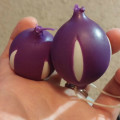
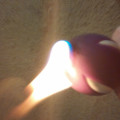
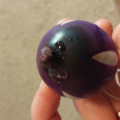
SILICONE: Another reviewer, Sex and Java, decided to flame test their Pleasure Works Cadet. It is labeled as silicone and thus far they’ve been a manufacturer to trust, but the package labeling caused concern. Why would a dildo be labeled “for external use only” and then proclaim to be “anal safe”? You can’t have it both ways, folks. The first photo below shows a lot of soot, but that’s to be expected so long as it washes off, and it does as seen in the 2nd photo. The 3rd and 4th photos show the disclaimer and then anal safe wording. This disclaimer and wording also appears on a buttplug of theirs, so it seems to be a standard disclaimer. I just can’t understand why a company who makes insertable sex toys would be a “for external use only” warning on the package. It doesn’t feel right.
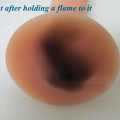
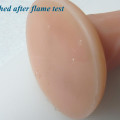

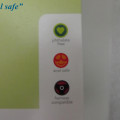
Regardless of the weird package warnings, this black soot/scorch mark is still normal. It’s because you’re not burning something “clean”, you’re using a lighter or match or something that gives off soot when it burns. So the longer you hold the flame to the material, trying to force a burn/reaction, the more soot you’ll get and something it won’t rub off. In this particular instance I would say that you can’t expect a burn result (to produce ash to tell that it’s silicone) if you’re holding the flame against that flat surface. You’d need to try the edge of the base. I’ve seen results of just minor soot marks on silicone from Fun Factory and Lelo, mainly because they are vibrators with no discernible “sharp” thin edge and no sections of super thin material. I couldn’t get a burn, so no ash. The soot is also probably a reaction of the dimethicone burning. When I cut the silicone skin off the Lelo Ina, I was able to catch an edge and get some white ash and minor smoldering burn.
—————————————————————-
Hi Lilly,
I ran across your informative blog while I was searching for information about silicone sex toys.
I’ve had this favorite dildo for a few years now, but I kept getting reoccuring vaginal infections after using it. Since I mostly used it during the times when my husband and I were intimate, I initially thought the infections were coming from sexual intercourse with my husband.
After reading your blog, I decided to do a flame test on the dildo. Within 2 seconds of the flame touching the dildo, it immediately started on fire. The entire thing was covered in light blue flames. To give it a fair chance, I tried it on 2 different spots (the shaft and the base), and both had the same results. It was scorched black and it stank really bad. I tried to rub off the scorch marks and it was melted and peeled off, revealing underneath a fibrous looking material.
I don’t think this is silicone and now I may have found the source of my infections! The issue is that this sex toy company is well known where I live (Europe) and I visited their website and viewed their description of my toy. It states “100% silicone” and “Phthalates free”.
Is it still possible for this toy to be silicone? Have you ever done a flame test on a silicone toy and had it go up in flames? If it isn’t silicone, how can they falsely advertise like that and cause women, like me, to get infections?
PROBABLY NOT SILICONE: The fact that it burned in this manner, covered in the light blue flames combined with the peeling and the lack of pale gray ash tells me it’s probably not silicone. If it was just covered in the blue flames, I would think that the company didn’t thoroughly rinse off the m0uld-release agent during production. I’ve burned a lot of silicone, and it’s never smelled great (you are burning chemicals, after all). TPR and jelly rubber did stink much, much worse though. And yes, if this is a porous toy it would absolutely be passing on a recurring infection! I’ve seen the blue-flames effect happen with silicone that was still covered in manufacturing chemicals but this person’s sex toy was not brand new.
What’s your opinion on Rocks Off toys? I bought one of them recently (an anal plug), the site had it listed as silicone. But then after I got it, I checked the Rocks Off site and on there it says “silicone rubber.” Which is disappointing. I tried the flame test and it did melt and come off on my finger when I rubbed it after. I tried my other two silicone toys (Dorcel and Fun Factory) and neither even had burn marks, they just got warm. There was some light grey ash, yes. I redid it to show how it rubs off and to show it better, my camera isn’t the greatest but a bit definitely gets removed. The spot on the toy stays tacky after.
SILICONE: My best answer to the “silicone rubber” term: “Silicone rubber” is a…. oh boy. there’s a word for these terms. Like “tin foil”. It’s no longer made from tin, but its a holdover saying. I have yet to actually find a logical reason for a company to create a material that is a combination of silicone and another porous elastomer. Silicone is expensive. When they say “silicone rubber” it’s a “rubber-like” sort of material. Pliable. Anyways, with regards to the results of the flame test, I’ve seen this. The sticky, the material loss but with the presence of ash. Because it smoldered and didn’t go up in a woosh (coupled with the ash), I still believe this to be silicone.
If you’ve flame-tested a toy, please email me with a photo of your results so that I can start sharing more here!
Disclaimer: I am explaining things in the best way I know how. I’m dealing here in many “facts” that I can’t tell you are all 100% accurate – we lack the ability to be super scientific about this. I don’t have a chemist by my side, I don’t have a lab. I’m sharing with you what we think, what we are inferring from results thus far, and what our reason and logic is filling in. The information here may change as we learn more–in fact this post is all about how the information is changing because we’ve learned more because I’m sharing more nuanced result facets than I could with the first flame test post. So understand that nothing is 100% certain but I’m doing my best and I fully believe that some things hold absolutely true – gray ash means silicone, and a hot, high burn like an oil lamp means plasticizers.
- Someone who didn’t publicly comment pointed out that Chavez Designs, formerly Jollies, has some “clear” dildos. There is a large difference though between the clarity of their silicone and the crystal-clear of TPR/Jelly; plus their stuff is very firm. Every dildo I’ve seen from them is a bit “cloudy” clear. Example 1 and Example 2 from Chavez. Now here is what I mean by crystal clear: Example 1 and Example 2. Now you will absolutely see cloud-clear TPR and Jelly, yes. But the feel is different, they’re very soft. Companies other than Chavez that make silicone in this translucent-yet-not-crystal-clear silicone are Vamp and Vixen. If you see others and question the material composition, let me know! ↩

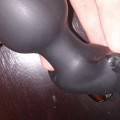





I appreciate all the hard work, energy, effort and thought that you put into your posts and the fact that you quickly said, I dont know everything, I might be wrong but here is what I know, good job! Keep up the hard work, you do make a difference!
Shellie
Vamp still casts in translucent silicone, as does Vixen.
Oh really! Do you happen to know which styles they make in their translucent? I’m less familiar with Vamp’s lineup than Vixen.
Vamp does any of their models in any of their colourways. Vixen’s silver glitter is a translucent silicone, as is the base mix for the g-whiz and g-whizzard. Been that way since forever.
Thank you!! :) I will add this to my note above. I forgot about the g-whiz! I have that. I’ll take a pic of it to add too.
(also I really need to branch out and try more Vamp and Vixen)
Thank you!! :) I will add this to my note above. I forgot about the g-whiz! I have that. I’ll take a pic of it to add too.
(also I really need to branch out and try more Vamp and Vixen)
Babeland is good retailer, yeah. As mentioned above, the presence of the sticky patch can still mean it’s silicone. But the fact that the material seems to have deformed…that’s iffy. I can’t really tell without seeing it or knowing the brand.
I took a look at it again- the damage is very minimal, there’s a light visible ring around the patch (which is no longer sticky, and the only deformation is that it’s a little flatter and slightly rougher than the rest of the toy.) But I’ve been getting little yeast infections every time I use it, maybe that’s from not having known how to wash it properly when I first got it… What do you think? (Thank you so much for all the help by the way!) (I’ll post a photo if I can.)
Without knowing what the item is, I’m hesitant to make any firm comments either way. As for the infections….are you certain it isn’t the lube? Lubes can get old, contaminated, etc or you might be having a reaction to an ingredient in the lube. What lube are you using? I would suggest that until you have it all sorted, you stop using the toy.
If you can, you could always email me photos of the item and I can try to identify it.
I realize that this is an old thread, but it got my thinking (and experimenting). Rather than destroy an entire toy, I cut off a sliver from the base of various “silicone” dildos and plugs; variety of brands. I held the sample above the flame of a disposable lighter with pliers. Some ignited, some sparkled, some smoldered. Most left a grey ash afterwards. Knowing this as not all that scientific, just curious as to whether using a small sized sample was valid. I use mostly glass or metal toys and am considering disposing of anything in the toy box that might be toxic.
Small sample is definitely valid. Everything you described sounds like you have silicone. If it were not silicone then it would burn like an oil lamp.
I’m so thankful for this post. I flame tested a translucent dildo made by utimi and I think it passed the test. Soot was left behind on it after the test on the larger areas and some of the more detailed parts on the shaft smoldered a bit but didn’t actually catch fire. Some white ash was left behind in the wake of the burning in those areas. I’m going to purchase another since it was fairly cheap.